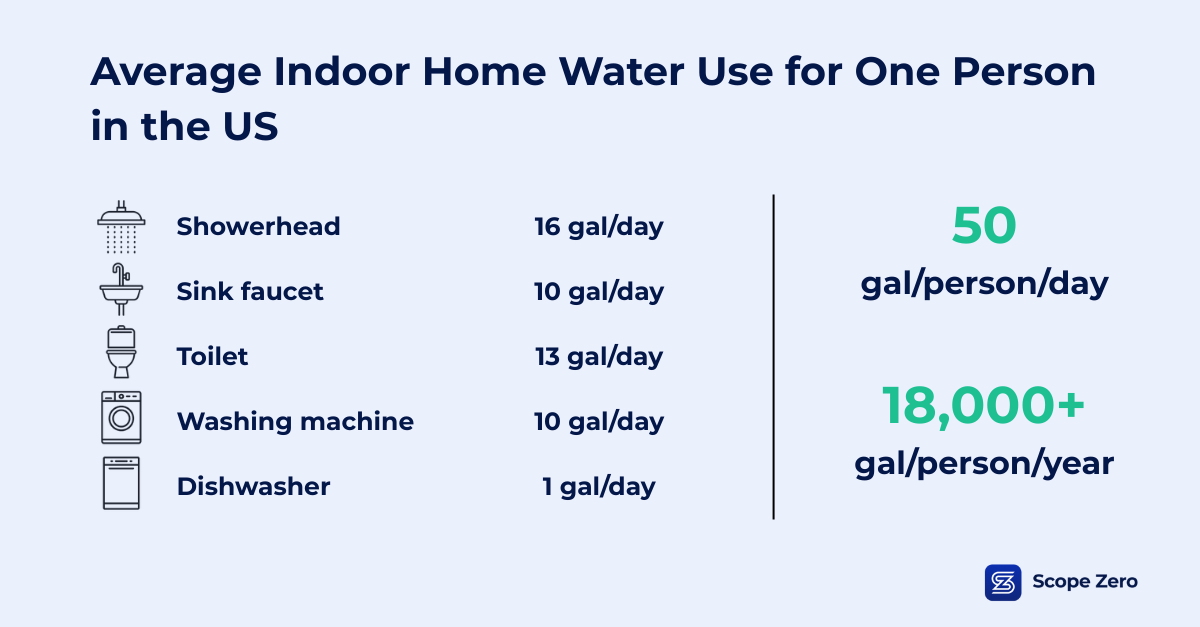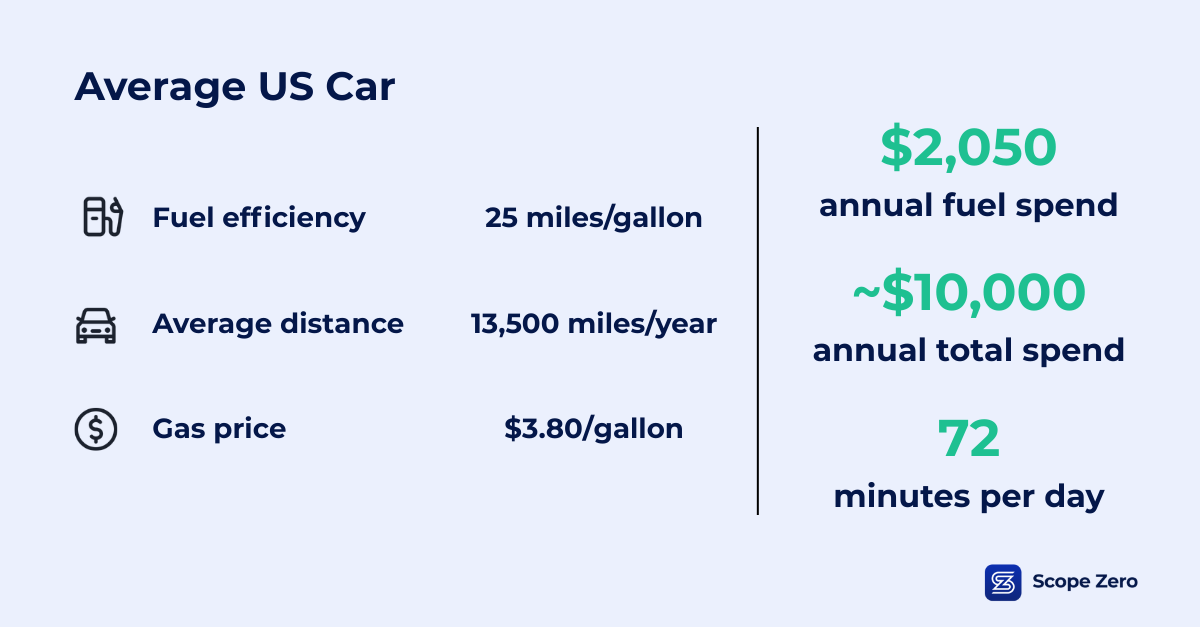May 6, 2025 • 11 min read
How to Reduce Your Carbon Footprint

As global support for climate action increases, many of us are asking the question: how can I reduce my carbon footprint? With a few simple changes to your home, transportation, and lifestyle habits, you can significantly lower your environmental impact while also slashing utility bills and fuel costs.
Whether you’re trying to reduce your utility bills and fuel expenses, or just looking to live more sustainably, this guide will walk you through high-impact strategies that will lower your carbon footprint and also save you money.
Table of Contents
Home Energy: Why Your Home Is One of the Biggest Levers for Emissions Reduction
Your home is one of the most powerful places to begin your carbon reduction journey. In the U.S., residential energy use accounts for a significant share of total carbon emissions.
The average home consumes over 10,000 kWh of electricity annually. The average person uses roughly 50 gallons of water per day indoors at home - more than 18,000 gallons per year. At-home indoor water consumption includes
- 16 gallons/day from showers
- 10 gallons/day from sinks
- 13 gallons/day from toilet flushes
- 11 gallons/day from laundry and dishwashing

Several factors influence a home's energy and water consumption, including its size, age, and geographic location. Older homes tend to be less insulated, leading to greater heating and cooling demands. Larger homes require more energy overall, while single-family homes don't benefit from the shared insulation provided by neighboring walls in apartment buildings. Behavior plays a major role as well. For instance, someone who leaves lights on in every room, regardless of how efficient their light bulbs are, can still see inflated utility bills.
Climate and geography also matter. According to EIA’s 2020 Residential Energy Consumption Survey (RECS), U.S. households in warmer states consume less site energy than households in colder states. Even your utility provider’s energy mix makes a difference in your electricity-related carbon footprint. If your electricity comes from coal or natural gas, your footprint is higher than in regions powered primarily by renewables. Tools like the EPA's Power Profiler can show you how clean the electricity you use is.
Home Technology Upgrades: What to Tackle and in What Order
For the average US home, we recommend a sequential approach to home technology upgrades. By tackling improvements in a specific order, from the easiest, most cost-effective changes to more substantial investments, you can maximize both environmental impact and financial savings. Here's how to get started.
Step 1: Start with the low-hanging fruit first
When it comes to reducing energy use, we recommend starting with low-cost, high-impact upgrades before moving on to bigger investments. These early improvements often pay for themselves quickly and set the stage for more advanced upgrades later on.
The best place to start is with lighting. If your home still uses incandescent bulbs, switching to LEDs can reduce lighting-related electricity use by up to 95%. Likewise, installing smart power strips can eliminate “vampire loads,” which are when electrical devices consume energy even when turned off or in standby mode. These loads can cost the average household up to $300 per year.
Water-saving devices are another easy win. Low-flow showerheads, sink aerators, and dual-flush toilets can cut indoor water use by nearly 50%. Not only does this reduce your water bill, but it also lowers the demand on your water heater, saving you costs in two areas (water and energy). If you can’t replace an entire fixture, accessories like toilet tank bags and faucet aerators provide budget-friendly options that still make a measurable difference.
Ready to implement these easy ways to save energy at home? Check out our blog post featuring 5 easy home upgrades you can make today.
Step 2: Improve insulation and address your building envelope
After tackling these low-hanging fruit, consider improving your home's insulation and air sealing, collectively referred to as the building envelope. Insulation reduces the amount of energy needed to maintain a comfortable indoor temperature, meaning you can invest in smaller, more affordable heating and cooling systems. In addition to traditional insulation, building envelope improvements include energy-efficient windows and doors, weather stripping, and reflective roofing materials.
Step 3: Upgrade heating and cooling systems
Once your building envelope is optimized, the next step is to upgrade your heating and cooling systems. Heat pump technology is among the most efficient and versatile solutions available, offering energy savings for both heating and cooling needs. Smart thermostats that adjust temperature settings based on your schedule can further enhance efficiency.
Step 4: Replace appliances with energy-efficient upgrades
When it comes to appliances, start with your water heater — especially if it’s over 10 years old. Heat pump water heaters use 2–3 times less energy than conventional tank models and even outperform many tankless systems. From there, consider replacing older refrigerators, washing machines, and dryers. Energy Star-certified models are typically the most efficient. It’s also worth noting that for refrigerators, top-freezer designs use less energy than side-by-side or French-door models.
Step 5: Explore solar panels or battery storage
Finally, once you've minimized your energy consumption through these upgrades, you can explore solar panels or battery storage. Reducing your home's energy demand first allows you to install a smaller solar array, lowering both upfront costs and long-term maintenance.
Modify Your Behavior: Small, Consistent Improvements That Add Up
While technology upgrades offer lasting improvements, your day-to-day behavior also plays a crucial role in reducing your carbon footprint. Many of these changes are simple and cost nothing to implement.
For example, dishwashers are typically more efficient than handwashing, especially when you skip the pre-rinse. Make sure to scrape, not rinse, dishes before using the dishwasher to minimize your water use. Similarly, shortening your showers and opting for cold water when possible reduces both water and energy use.
Turning off lights and electronics when they’re not in use is another easy habit with outsized benefits. For devices with hard-to-reach plugs, power strips (especially smart ones) make it easier to reduce standby energy consumption. Adjusting your thermostat, dressing appropriately for the weather indoors, and strategically opening or closing blinds to regulate temperature can also lower your heating and cooling needs.
One lesser-known behavioral strategy is repurposing gray water. For example, some toilets now come with integrated sinks that reuse handwashing water for flushing, or you can place a bucket in your shower to collect water as it’s heating up. Another important mindset shift involves avoiding what’s known as Jevons Paradox — the tendency to use more of a resource once it becomes cheaper or more efficient. Just because your home is more efficient doesn’t mean you should leave the lights on longer or keep the thermostat higher.
Think Big Picture: Rethink Your Living Situation by Making Structural Changes
Where and how you live matters. Beyond personal behavior, structural factors like how and where you live can significantly impact your emissions. Downsizing to a smaller home not only reduces heating and cooling needs but also decreases the number of appliances and devices drawing electricity. Sharing a home with roommates or family spreads energy use across more people, lowering per-person consumption.
Living in an apartment or multi-unit building offers additional efficiencies with shared walls, reducing heating and cooling demands. And denser living in urban areas supports car-free lifestyles and lower transportation needs. This overlap between housing and transportation benefits makes denser living a powerful strategy for those seeking to reduce their footprint.
Transportation: Rethinking the Commute and Beyond
Transportation is another major contributor to individual carbon footprints. Residential energy and passenger vehicles account for about a third of all energy-related carbon emissions in the United States. Financially, car ownership costs over $10,000 annually when you factor in payments, fuel, insurance, maintenance, and parking. Add to that the average of 72 minutes per day spent in the car, and the case for reevaluating your transportation choices becomes even stronger.

Drive Smarter: Everyday Transportation Habits That Lower Emissions and Costs
Behavioral changes are a great place to start. Carpooling helps reduce per-person emissions, while planning errands efficiently can minimize unnecessary trips. Reducing the weight in your car can improve fuel efficiency, where every 100 pounds of extra cargo can decrease your miles per gallon by about 1% to 2%. And keeping up with regular maintenance, like tire inflation and oil changes, can improve fuel efficiency by up to 3%. Even driving habits matter, where avoiding hard acceleration and braking can increase fuel efficiency by as much as 33%.
Invest in Cleaner Tech: Upgrade Your Vehicle and Embrace Micromobility
Upgrading your vehicle is another powerful step. Electric vehicles (EVs) produce significantly fewer emissions than their gas-powered counterparts, especially when powered by clean electricity. EVs are also becoming increasingly affordable as they are cheaper to maintain and benefit from various federal and local incentives. Smaller vehicles and micromobility options like electric scooters or bikes offer additional low-emission alternatives, especially for short trips.
Rethink Your Routine: Make Location-Based Choices That Minimize Driving
Structurally, relocating closer to work, school, or frequently visited destinations can dramatically reduce your transportation emissions. Sharing a vehicle with roommates or family members is another way to cut costs and emissions. The ultimate solution, however, is to go car-free and rely on public transit, biking, or walking—options that are most viable in urban, high-density environments.
Food: An Overlooked Piece of the Carbon Puzzle
While less frequently discussed in the context of energy bills, your diet has a major influence on your overall carbon footprint. Studies show that heavy meat eaters may have a diet-related carbon footprint comparable to their annual home emissions. Choosing a vegetarian or mostly plant-based diet can significantly reduce this impact. Contrary to popular belief, while eating locally can influence the footprint of your diet, it’s a much smaller impact than changing the types of food you consume, as the majority of food-related emissions stem from agricultural practices.

Source: Our World In Food, Food: greenhouse gas emissions across the supply chain
There’s also a clear link between food habits and home energy use. For instance, meal prep saves oven time and energy. Sharing meals and avoiding food waste reduces refrigeration and disposal costs. Letting hot food cool before placing it in the fridge, and minimizing how long refrigerator doors are open, can further conserve energy.
Waste Reduction: Minimize What You Send to the Landfill
The average American generates nearly five pounds of trash per day, much of which ends up in landfills, releasing methane. The foundational principle of waste reduction is to Reduce, Reuse, Recycle. Reducing your overall consumption is the most effective way to cut down on waste. This might mean choosing products with minimal packaging, buying in bulk, or simply resisting impulse purchases. Reusing containers, bags, and other everyday items further extends their life and reduces the demand for new materials.
Recycling may seem like a simple step, but it’s important to know what your local recycling program actually accepts — placing the wrong items in the bin can contaminate entire batches. Check with your city or waste hauler to find detailed guidelines, and when in doubt, look for recycling labels and numbers. Recycling materials like aluminum and cardboard saves significant energy and reduces the need for virgin materials. Composting is another powerful way to cut down on waste and emissions. You don’t need a large backyard to get started, with many cities offering curbside compost pickup and countertop composters working in apartments. Recycling and composting prevented 94 million tons of waste from reaching landfills in 2018, reducing emissions by the equivalent of taking 42 million cars off the road.
Wrapping It Up: Start Small, Save Big
Reducing your carbon footprint doesn’t have to be expensive or overwhelming, with many of the most effective changes also lowering your bills and improving your quality of life. With a few intentional upgrades and mindful habits, you can dramatically lower your environmental impact while saving money on energy, water, and transportation.
In short, here’s how to start small and save big:
- Start with simple tech upgrades: LED lights, low-flow devices, smart power strips.
- Rethink your behavior: Unplug, dress for the season, plan travel.
- Optimize your space and location: Smaller, shared, and central housing saves money and carbon.
- Your diet matters: Not just for health, but for the planet too.
- Reduce, reuse, recycle: Keep items out of the landfill through proper disposal and curbing what you use.
If you’re looking for support in making these changes, Scope Zero’s Carbon Savings Account® offers an innovative employee benefit that helps you cover the cost of home and transportation upgrades. From personalized recommendations to access to rebates and reimbursements, the CSA takes the guesswork out of sustainable living.
Carbon Reduction FAQs
What’s the easiest way to lower your carbon footprint at home?
Start with LED lighting, low-flow fixtures, and smart power strips. These upgrades are cheap, fast, and offer immediate savings.
Is upgrading to solar the first action I should take?
Before upgrading to solar, it’s best to reduce your home’s energy demand first through efficiency and insulation. Then solar becomes cheaper and more effective.
Does switching to an electric car make a big difference?
EVs typically produce half the emissions of gas-powered cars over their lifetime. Plus, they’re cheaper to operate.
Does it save more water to hand wash dishes over using a dishwasher?
A full dishwasher uses less water and energy than handwashing, especially if you skip pre-rinsing.
Is eating locally produced food the best choice I can make to reduce my carbon footprint?
Eating locally makes an impact but it's significantly less than changing the types of food you eat. Reducing meat intake is one of the most impactful dietary changes you can make.
Get the tools you need to reduce your carbon footprint
Scope Zero’s Carbon Savings Account® (CSA) helps individuals lower their cost of living by making home and personal transportation upgrades affordable and accessible. The CSA is a financial wellness benefit that reduces cost of living, drives environmental impact, and advances corporate ESG goals.
Join our community
Sign up for our newsletter to stay up-to-date on all things Scope Zero.







 Platform
Platform




